The medical aesthetics industry is expected to reach more than $19 billion in sales globally by the end of 2023. Below is a list of five medical aesthetic trends we anticipate will contribute to industry growth this year.
And thanks to these trends, McKinsey predicts that the market for aesthetic injectables could grow 12%-14% per year through 2027.
Trends:
- Injectables Continue to Become More Mainstream
Shifting consumer perceptions about beauty, aging, wellness have brought aesthetics injectables – once considered treatments for only the rich and famous – mainstream.
The increased popularity in working from home (a.k.a “Zoom Boom”), Instagram filters, and influencers are strong contributors, too. Social media is aiding in awareness and normalization, as it’s no longer uncommon for influencers to talk about their treatments or film themselves getting a procedure done. Rachel Parcell, a Utah-based influencer with over a million followers on Instagram, recently filmed her experience getting her frown lines treated with Xeomin by Dr. Megan McClean on her Instagram account. The reel received over 200,000 views.
Additionally, the growth of the overall market has made aesthetics treatments more accessible to consumers. According to a 2021 McKinsey report, more than 400 aesthetics clinics and care centers have raised $3.1 billion from investors over the past five years, making them the fastest growing segment of the aesthetics industry.
Synergy’s partnership with Merz Aesthetics brings you access to a variety of cutting-edge injectable technologies, including Xeomin and Radiesse. Contact us today to learn more.
- Increase in Millennial and Generation Z Patients
Gone are the days where your practice’s typical patient is a female earning six-figures in their forties. Patients in their twenties are becoming increasingly more common as they look for treatments to help them prevent aging, instead of waiting to treat aging concerns as they arise.
Popular treatments amongst college-aged women include lip flips and lip fillers, along with more involved injectable procedures like cheek volumization.
- Heightened Demand Among Men
Between 2018 and 2021, the male makeup of the neuromodulator market jumped from 10% to 15%. This is likely in part to the rise of minimally invasive “lunchtime” procedures that can be done quickly and do not require any social downtime.
- More Brand Loyalty Among Patients
Five to ten years ago, it was common for patients to come to your practice having already done extensive research about the procedure they were seeking, but it was unlikely that they knew very much about the particular brands used for the treatment.
More recently, patients have become increasingly brand conscious and loyal. It’s no longer uncommon for patients to ask to be treated with their preferred brand, and even question or refuse treatment from a competitor’s product within the same category. They are also more well versed about what’s happening and what’s trending, according to Dr. Tingsong Lim.
- Growing Number of Medical Aesthetics Providers
More RNs, NPs, PAs, physicians and even dentists are pursuing aesthetics training because the market for injectables indicates such a strong growth opportunity.
As you look to keep your practice’s skills as sharp as possible, consider partnering with Synergy EDU for access to ongoing training opportunities. Our 3-Level certification program advances skills and connects aesthetic practices together across the Synergy region.
The Synergy EDU Injector Certification and workshops not only build provider knowledge and expertise, but develop selling and marketing skills for every Synergy Aesthetics customer.
At Synergy Aesthetics, we are here to support you. Contact us today to learn how you can turn these trends into wins for your practice – your success is our success!
Sources: Merz Aesthetics, The American Association of Aesthetic Medicine & Surgery



